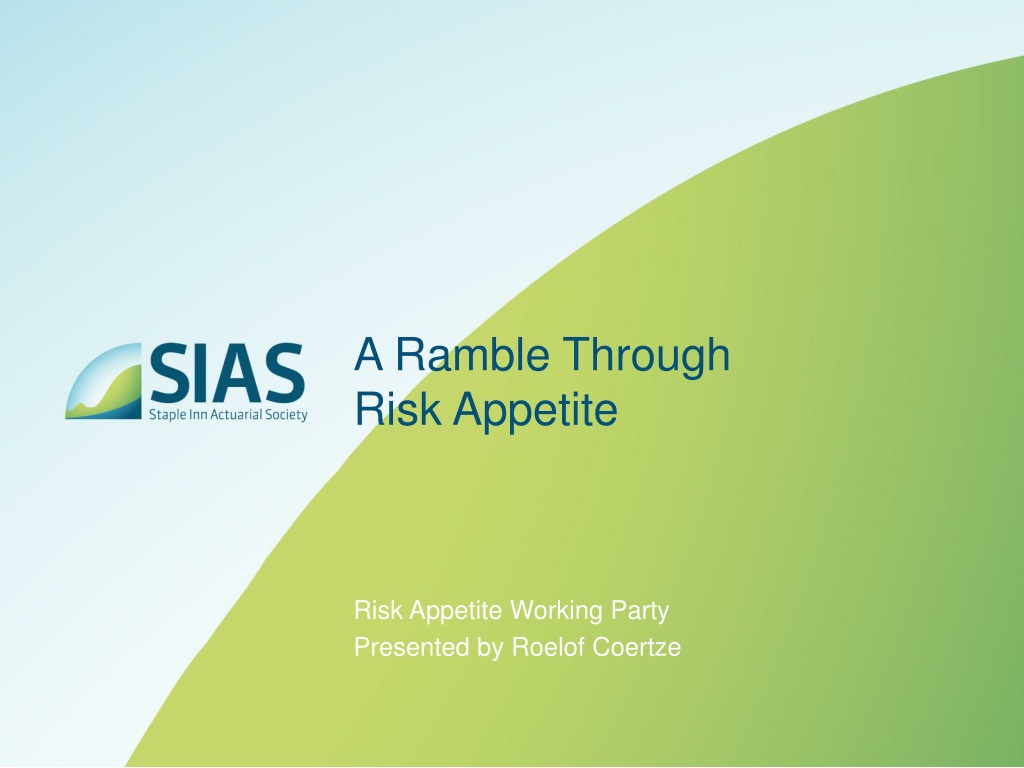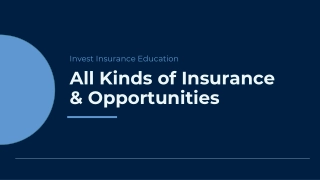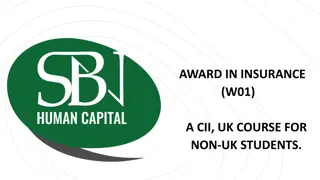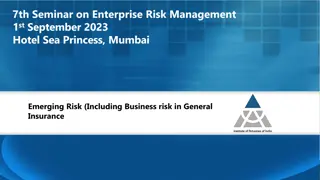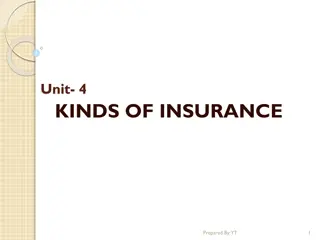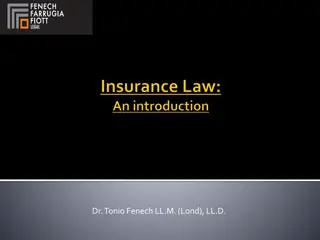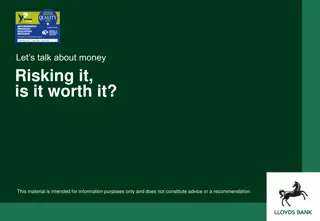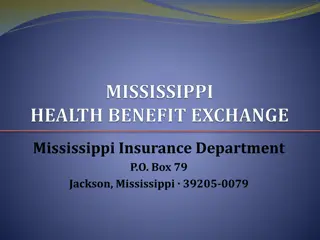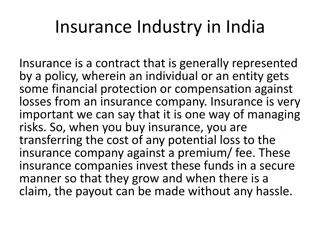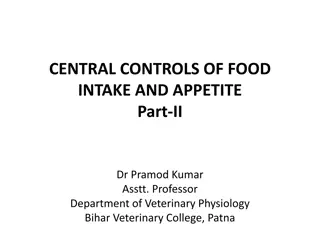Exploring Risk Appetite in Insurance Industry
Delve into the concept of risk appetite in the insurance sector through the perspectives of various insurers and companies. This presentation highlights the significance, link to value creation, regulatory context, and implementation practices related to risk appetite frameworks in the industry.
Download Presentation

Please find below an Image/Link to download the presentation.
The content on the website is provided AS IS for your information and personal use only. It may not be sold, licensed, or shared on other websites without obtaining consent from the author. Download presentation by click this link. If you encounter any issues during the download, it is possible that the publisher has removed the file from their server.
E N D
Presentation Transcript
A Ramble Through Risk Appetite Risk Appetite Working Party Presented by Roelof Coertze
Disclaimer The views expressed in this presentation are those of the authors, The Risk Appetite Working Party, of the paper and not necessarily of the Staple Inn Actuarial Society or authors employer(s)
Contents Introduction Literature Review Public Risk Appetite Statements Questionnaire
When We Started Although risk appetite is a relatively new concept, it is already a key part of the enterprise risk management approach for firms in all industry sectors, not just insurance.
Original Scope of Working Party What does Risk Appetite mean to the different insurers? What is the importance of Risk Appetite for insurance companies? How does Risk Appetite link to return and value creation? What are the applications of Risk Appetite by life insurers? What is the context of Risk Appetite in regulations (including Solvency II)? What are the practices adopted by various life insurers for implementing a Risk Appetite Framework?
The Work Undertaken by the Working Party Performed a literature review Reviewed publicly disclosed risk appetite statements Conducted a questionnaire of UK insurance groups and companies
Themes Covered by the Literature Review Definition for Risk Appetite Other key definitions Risk Appetite in the context of Risk Governance Benefits of having a Risk Appetite Framework Core principles of a Risk Appetite Framework Potential risks faced by Life Insurers Best practice and potential pitfalls when implementing a Risk Appetite Framework
Definition of Risk Appetite A series of boundaries, appropriately authorised by management, which give each level of the organisation clear guidance on the limits of risk which they can take, whether their consideration is of a threat and the cost of control, or of an opportunity and the costs of trying to exploit it. 20 September 2024
Other Key Definitions Risk Capacity is the maximum level of and type of risk an organisation is able to support before breaching constraints determined by regulatory capital and liquidity needs and its obligations to customers, shareholders and other stakeholders. Risk Appetite: The aggregate level and type of risk that an institution is willing and has the capacity to assume or avoid in order to achieve its strategic objectives. The Risk Tolerance is a quantitative or qualitative expression of the maximum risk allowed by the risk appetite. Risk Limits are the translation of the risk tolerances into day-to-day practical boundaries to operations
Risk Appetite in the context of Risk Governance The board of directors and the company s governance structures should be involved in establishing, maintaining and embedding the Risk Appetite Framework in the business The FSB noted Boards that approve the risk appetite statement, however, tend to have a higher level of understanding of the financial institution s risk appetite than when it is received or noted .
Benefits of a Risk Appetite Framework Enabler of good enterprise risk Risk Appetite management Business Strategy Risk Strategy Improved understanding of what generates value vs. what generates Business Decisions Identify risk Review People and processes Business decisions based on optimising the risk-return profile Monitor Measure Improves chances of achieving strategic objectives Manage Reduced impact of external events for Governance and Culture policyholders and shareholders Lower cost of capital Example Risk Appetite Framework Reduced regulatory scrutiny
Core Principles for a Risk Appetite Framework Category Development Establishing a comprehensive RAF is complex, iterative process CRO Forum & NARC Institute of Risk Management RA should be developed in the context of an organisation's risk management capability (risk capacity and risk management maturity) RA needs to take into account differing views at strategic, tactical and operational level Should use key risk and control metrics FSB Should be both top-down Board leadership and bottom-up with involvement of management at all levels, The diverse interests of parties relevant in achieving company objectives should be considered; Risk appetite framework should identify and quantify risk preferences for material risks; Measurements should be used to provide evidence of risk appetite and strategy alignment at the enterprise and business segment levels; For risks that are inappropriate to quantify, qualitative boundaries should be developed and assessed. RAF should be a defence against excessive risk-taking RAF should cover activities, operations and systems within its risk landscape but are outside its direct control Features Risk appetite is complex, needs to be measurable, flexible, not a fixed concept Data governance: Data should be accurate and consistent with routine accounting data Propensity to take risk, propensity to exercise control
Core Principles for a Risk Appetite Framework Category Embedding CRO Forum & NARC The risk appetite framework should be cascaded to business segments to ensure decisions are consistent with enterprise objectives, tolerances and limits; Institute of Risk Management RA needs to be integrated with the control culture of the organisation FSB RA should be embedded into the organisation's risk culture; Communication of RAF across the company and also with external stakeholders The RA statement should be used in the organisation's decision making process RAF should be adaptable to changing business and market conditions Risk appetites should be reassessed after significant events and reviewed by the Board at least annually. Reviewing
Risks Faced by Insurers Lower Level Risk Risk Category Non-life premium and reserve risk Non-life catastrophe risk Non-life lapse risk Life mortality risk Life longevity risk Life disability morbidity risk Life lapse risk Life expense risk Life revision risk Life catastrophe risk Health mortality risk Health longevity risk Health disability morbidity risk Health expense risk Health revision risk Health lapse risk Health catastrophe risk Interest rate risk Equity risk Property risk (credit) Spread risk Currency risk Concentration risk Credit counterparty risk Operational risk Non-Life Underwriting Risk Life Underwriting Risk Health Underwriting Risk Market Risk Counterparty Default Risk Operational Risk
Best practice: Implementing a Risk Appetite Framework Risk Identification: The first stage in the implementation of a Risk Appetite Framework is to 1. identify all risks that the firm may face. In addition to financial and insurance risks, firms need to consider strategic, reputational, conduct and group risks. Also consider emerging risks separately. 2. Risk Appetite Statements: The next stage is to express the firm s appetite for each risk. Broadly speaking, the risk appetite statements can be grouped into two main categories: 1. Qualitative risk appetite statements 2. Quantitative risk appetite statements Maintaining and Communicating: Developing and implementing a RAF is not just a one-off 3. exercise. It could be reviewed as part of the regular business planning cycle and/orif there are material changes to the company s strategy or the markets. Cascading: Cascading risk tolerances down through the company ensures that the business 4. operations are consistent with the strategic direction of the company Monitoring and Reporting: Distinguishing between hard and soft limits is useful in determining 5. when discussions around revising risk limits are warranted.
Potential pitfalls It is often difficult to measure risk appetite or risk exposures There is a danger inappropriate targets are set Vague expressions of risk appetite and / or risk limits A failure to cascade or roll out the RAF Over reliance on key risk indicators (KRIs) Unnecessarily constraining of risk-taking Failure to consider all stakeholders
Findings from Public Risk Appetite Statements
Characteristics of Effective Risk Appetite Statements From the Literature Review: It s critical that a risk appetite statement is clear and can be implemented across an organisation. The qualities of a good risk appetite statement are summarised by the CRO Forum & NARC (2013, p8) as follows: Comprehensive: it should have the appropriate breadth, reflecting coverage of risk landscape, and depth, meaning granularity within company structure; Concrete and Practical: all material risks should be identified and quantified via risk tolerances. For risks inappropriate to quantify, qualitative boundaries should be established; Consistent and Coherent: tolerances throughout the company need to form a balanced system of relevant boundaries, avoiding excessive allowance in some areas and excessive restrictions in others, and should align with the business model of the company.
Terms referenced in Risk Appetite Statements Customer / Reputation Company Strategy Capital Earnings Liquidity Y Y Y Y Y Y Y Y Y Y Y Y Y Y Y Y 1 2 3 4 5 6 Y Y Y Y Y Y Y 7 8 9 Y Y Y Y Y Y Y Y Y 10 11 12 13 14 15 Y Y Y Y Y Y Y Y Y Y Y
Features of the Questionnaire Sent out by the Institute and Faculty of Actuaries to UK based insurers Received 50 responses, though not all questions were answered by all respondents. The information the working party received was anonymised and turned into many bar charts
Respondents to the Questionnaire Assets under management bn Attributes of survey respondents 0-10 10+-50 50+-100 100+-200 201-above
Impact of Risk Appetite statements How much does your Risk Appetite framework impact the following activities? Does your firm have defined Risk Appetite statements? Yes No
Stakeholders involved in setting Risk Appetites Governance of Risk Appetite statements Consulted on defining the Risk Appetite Owns Risk Appetite Propose the Risk Appetite for approval Responsible for the Risk Appetite implementation and monitoring
Top Down vs. Bottom Up Risk Appetite Risk Preferences Top down Bottom up Combination Risk Limits Top down Bottom up Combination Top down Bottom up Combination
Cascading the Risk Appetites Level to which Risk Appetite is cascaded Group/Top level Divisional/Entity level Business Unit level Product line Other How quantitative Risk Limits are calibrated for use in monitoring Using stress and scenario testing and reverse stress testing Using approximations Challenge and debate of Board, NEDs and Senior Management Benchmarking against industry data Using External Assistance
Level of embedding How embedded would you suggest your Risk Appetites are within the business? How successful has monitoring against the Risk Appetite statements been? Identifying breaches Proactively discussing de- risking options Increasing awareness of risk within the Board Informing decisions where more risk could be taken Driving the business plan Senior management only Enterprise wide
Looking to the future Areas of future development Do you anticipate changes in the Risk Appetite statements or framework following the market volatility due to the decision of the United Kingdom to leave the EU? Embedding Risk Appetite in decision making process Value creation Risk return optimisation Buy-in from business on the application of Risk Appetite Clarity on regulations relating to Risk Appetite Risk Appetite Modelling Yes No Other (please specify)
Questions? Roelof.Coertze@gmail.com
BIG thank you to the working party members and those who completed the questionnaire
A Ramble Through Risk Appetite Risk Appetite Working Party Presented by Roelof Coertze
